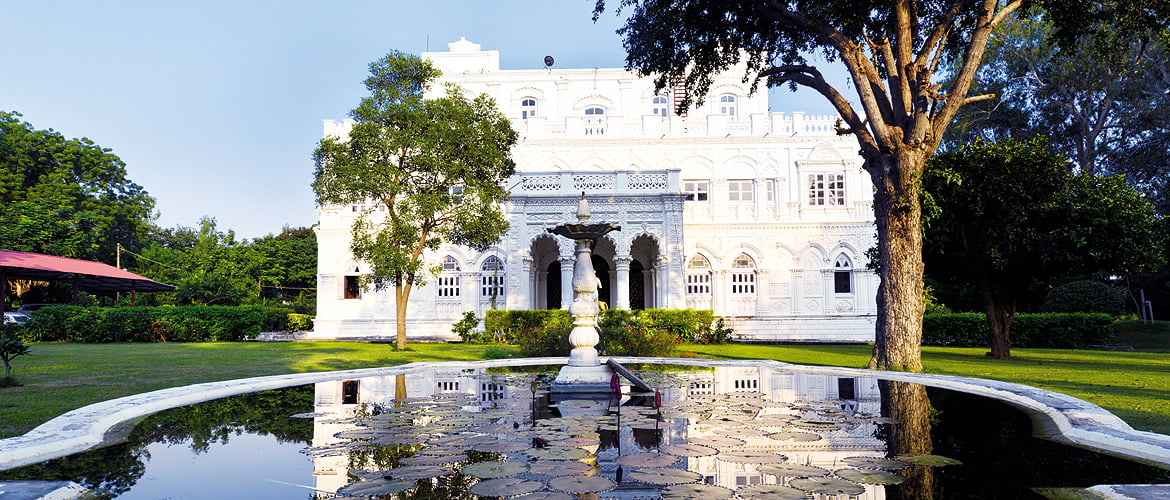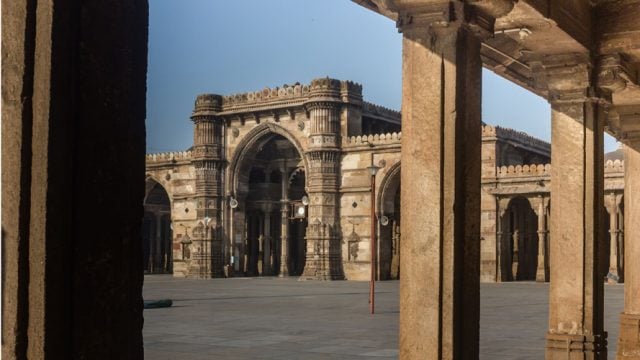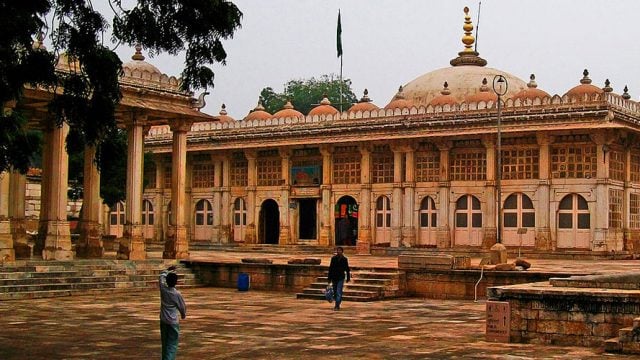A smooth, green, two-and-a-half-hour drive from Ahmedabad (but of course, this is prime ministerial country!) and we
I leave the car to receive a royal welcome. Almost literally: if we had been living in a time before India became a sovereign democratic republic, which reduced all of us to honorific-less equals, I could have claimed bragging rights by being received by His Highness Maharaja Tushar Singh and his wife Maharani Ambika Kumari. But, perhaps, the graciousness of a royal past is an inherited trait—and Mr and Mrs Singh have the most gracious smiles.

A clutch of dogs runs up and proceeds to make my welcome a rousing one. My hosts walk me indoors and there’s plenty to please the eye here too. In that first instance, I take in time-buffed terracotta floor tiles, a handsome but unostentatious wooden staircase, sepia-tinted family portraits, old but lovingly maintained furniture, high ceilings and stained-glass windows. Nothing is shiny or garish, not a grandiose note can be heard. My mind clicks a snapshot of gracious living, an intangible inheritance as precious as this beautiful building and its contents.
This is all quite removed from what I had expected. My basic pre-trip research had informed me that Devgadh Baria, located in Dahod (formerly Panchmahal) district of Gujarat, was the royal seat of the region in the pre-Independence era. The closest railway station is Godhra, 45km away; the contemporary association is uncomfortable. But ensconced in this erstwhile royal haven, it’s easy to leave those thoughts behind.
Outside the large window in my spacious, airy room, I can see a vista dotted with gentle green hills and a picturesque lake. Panchmahal has a jollier claim to fame: the Ratanmahal Sloth Bear Sanctuary, right next door, plays host to a large number of these fascinating creatures. Once upon a time, these animals too were loyal subjects of my royal hosts. This is the catchment area of an important Gujarati river, the Panam.
It’s time for lunch, as well as time to make my acquaintance with the matriarch of the household—(Princess) Urvashi Devi. Over a delectable lunch of fried fish and makke ki roti paired with spicy Rajasthani curry and vegetables, I am regaled with new flavours and fascinating histories. First, the food. I am eating du terroir: the fish was caught a few hours previously from the nearby lake, lightly marinated and then fried. Makka (corn) is an agricultural staple in Devgadh Baria. Rajasthani flavours subtly mingle with Gujarati ones to create an all-new experience on this table.
Then, the stories. The grey-haired royal recounts her past, garnished with nostalgia: “I spent my childhood in this house. The construction started in 1904 and continued till 1924. The first resident was Maharaja Ranjitsinhji. The last one to stay here till 1975 was my father, Maharaja Jaydeep Singh. He then gave this building to the agriculture department to run a government college.”
The family was given possession of this palace again three years ago. I can only imagine the effort and expense that must have gone into bringing the structure back to this charming condition from the depredations of state control (agriculture department, government college!).
As with so many erstwhile royals, who may have lost political power but continue to exercise a benevolent influence in their lost kingdoms, the Singh family currently runs a couple of schools and charitable institutions.

After a refreshing nap, it’s time to drive up to Devgadh. A short trek uphill or a 20-minute drive brings one atop the hill which offers panoramic views—lush green on one side; houses, lakes and palace on another. The scenic spot has a little temple, which locals believe to be a powerful spiritual spot. For centuries, this sacred space has been witness to many wishes being fulfilled. For every wish fulfilled, the tribals offer a terracotta horse and even today, many come back to offer their thanks.
Dinner is on the terrace, under a full moon. There’s a nip in the air. Soft music, good company, good food. What wonderful hospitality, I think. What a fine heritage hotel this would make, I suggest to my hosts. Turns out this thought has already struck them! Watch this space, dear readers…

The next day, I am to leave for another erstwhile royal residence, this one already functioning as a heritage hotel. We planned on an early start but by the time we finish brunch, bid a grateful farewell to our hosts and hit the road, it’s almost noon. Four hours later, we reach the small town of Himmatnagar, further south in the state. It’s like any other small town in India, lined with little shops on both sides of the road, small kiosks along the pavement and vendors loudly proclaiming their wares. Finally, we sight Dowlat Villas Palace.
Spread over 30 acres, this mansion near Idar is home to Bhagirath Singh, Rita Rajya Laxmi, Suryavir Singh, Gitanjali Kumari and Hridayaansh Singh Idar. Receiving a second royal welcome, we enter and walk down a seemingly endless hallway. Adorning the walls are photos of the family’s royal ancestors; animal skins from long-ago shikaars act as startling rugs. (I almost trip over the head of a furry bear shot over five decades ago.)

An enormous spread lies before us at the lunch table, plated in silver dishes. Between courses, Suryavir tells us of his family’s history: several interstate marriages have led to a unique confluence of cultures and traditions. Suryavir’s wife Gitanjali is from the Surguja royals of Chhattisgarh and his mother from Nepal.
The fun continues as we pile into Suryavir’s precious possession—the World War ll Willys Jeep for a joy ride. And a right royal ride it is, in this left-hand drive icon, to the outskirts of town. Peace reigns here—few vehicles, lush greenery, dotted with the remains of a few Shiva temples. Virtually lost to history, they are occasionally visited by locals. The setting sun lights up the landscape, the hillocks at a distance, a flock of birds flies over our heads. People are seen heading home after a long day’s work. Along the way, friendly smiles welcome us to their town. ‘Idyllic’ would be the most appropriate cliché here.

Dinner’s served on the terrace of their residence. Conversation flows easy, interspersed with stories of their royal lineage, moving around the rajputanas and coming to the current state of political affairs. A warm and witty host, Bhagirath Singh is a man who likes to know everything and opine on it too. Dinner is light, made up of bakes and breads, followed by a pudding, for there’s an early morning excursion scheduled to the Polo Forest.
The early-morning drive leads us past narrow streams of water, hills and boulders. Walking through these untouched parts, it’s difficult to believe that this was once the stomping ground of hunt-hungry royals.
We find a quiet little corner next to a stream to enjoy our breakfast picnic. And then begins the walk towards the heritage sights inside the forest. A series of 15th-century Jain temple ruins, some surprisingly large, some yet to be fully excavated—all of them under the protection of the ASI.
The region is also noted for its Idar Fort. Also known as Ilva Durga, I am told it finds mention in the Mahabharata too. We hurry through our visit to the fort, as our royal hostess has promised to treat us to a Nepali lunch. As lunch is being prepared, we walk around the palace, taking in the history that lurks in each nook and corner. There’s much to witness—vintage picnic baskets, old weapons, arms and ammunitions, a library with classics and family journals, family portraits and fascinating glass furniture.
Lunch is another surprising mélange of tastes: a Nepali black dal, a range of pickles, vegetables, fried okra, chutneys and purées, yogurt and some special seasoned rice. Few have tasted these flavours. Or the unique experience: authentic Nepali food in a princely hamlet of Central Gujarat. I heartily recommend that you do too.
Inevitably but too soon, it’s time for khammagani.
The information
Getting there
There are daily flights from all major cities to Ahmedabad. From Ahmedabad, you can drive to Devgadh Baria (169km) and Himmatnagar (85km). Alternatively, you can also take a train from Delhi or Mumbai to Godhra and then drive down to Devgadh Baria. For Himmatnagar, there are trains from Delhi, Mumbai and Ahmedabad.
Where to stay
DEVGADH BARIA The nearest accommodation is Kanjeta Eco Campsite at Ratanmahal Sloth Bear Sanctuary, which is about 50km away. (Rates vary according to season. CONTACT: 0265-2425136, gujarattourism.com)
HIIMMATNAGAR Dowlat Villas Palace in Mahavirnagar, Dowlat Villas Palace road is a heritage hotel. The current royal family of Idar also resides here. Room rates from ₹3,500 onward, vary according to season. CONTACT: +91-9825500306; www.dowlatvillaspalace.com
What to see & do
DEVGADH BARIA Take nature walks, drive to Chougania Pass, go to Khos Valley or have a picnic by the Man Sarovar. Indulge in the local food. Visit the Ratanmahal Sloth Bear Sanctuary.
HIMMATNAGAR The palace itself has a lot to offer including bespoke dining experiences, a games room with carrom and table tennis, a tennis court and a library. Take a stroll amidst pristine nature, picnic at Polo Forest, check out historical excavations, visit the Jain Temples, Calico Museum and the 15th-century Idar Fort.
Devgadh Baria
Dowlat Villas Palace
Gujarat





